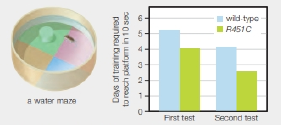
Concept explainers
Enhanced Spatial Learning Ability in Mice Engineered to Carry an Autism Mutation Autism is a neurobiological disorder with symptoms that include impaired social interactions and repetitive, stereotyped patterns of behavior. Around 10 percent of autistic people also have an extraordinary skill or talent such as greatly enhanced memory.
Mutations in the gene for neuroligin 3, an adhesion protein that connects brain cells, have been associated with autism. One of these mutations is called R451C because the altered gene encodes a protein with an amino acid substitution: a cysteine (C) instead of an arginine (R) in position 451.
In 2007, Katsuhiko Tabuchi and his colleagues introduced the R451C mutation into the neuroligin 3 gene of mice. The researchers discovered that the genetically modified mice had impaired social behavior and superior spatial learning ability.
Spatial learning in mice is tested with a water maze, which consists of a small platform submerged a bit below the surface or a pool of water so it is invisible to a swimming mouse. Mice do not particularly enjoy swimming, so they try to locate the hidden platform as quickly as they can. When tested again later, they remember the platform’s location by checking visual cues around the edge or the pool. How quickly they remember is a measure of their spatial learning ability. FIGURE 15.14 shows some or Tabuchi’s result.

FIGURE 15.14 Spatial learning ability in mice. Mice with a mutation in neuroligin 3(R451C) were tested for learning performance: as compared with unmodified (wild-type) mice.
In the first test, how many days did it take unmodified mice to learn to find the location of a hidden platform in 10 seconds?
To determine: How many days wild mice took to learn to find the hidden platform in 10 seconds.
Introduction: Autism is a neurological disorder in which patients have impaired social interactions, repetitive, and stereotyped behaviors. The condition appears due to the mutation in the gene neuroligin-3 and an adhesion protein that connects the brain cells together. The mutation causes substitution of a cysteine (C) amino acid by arginine (R) in position 451.
Explanation of Solution
The experiment was performed to test the learning ability of autism mice. The mice were mutated for R451C in neuroligin-3 gene by Researcher K, and it was found that the mutated mice had impaired social behaviors as well as superior spatial learning abilities. The spatial learning ability of mice have experimented with a water maze in which a small platform was little bit submerged below the water surface so that it cannot be observable to the swimming mice.
Mice do not prefer to stay in the water. Therefore, as quickly as possible, they find the hidden platform by remembering the spatial visual cues. Their learning abilities were assigned as quickly as they remember the hidden platform in the water maze. Refer to Fig. 15.14 “Spatial learning ability in mice” in the question; the data shown are the number of days training required for the wild (unmodified) mice and mutated (modified mice) to reach the platform in 10 seconds. In the first test, unmodified mice took little over five days to find the location of a hidden platform in 10 seconds.
In the first test, unmodified mice took little over five days to find the location of a hidden platform in 10 seconds.
Want to see more full solutions like this?
Chapter 15 Solutions
Biology: The Unity and Diversity of Life (MindTap Course List)
Additional Science Textbook Solutions
Chemistry
SEELEY'S ANATOMY+PHYSIOLOGY
Biology: Life on Earth with Physiology (11th Edition)
Laboratory Manual For Human Anatomy & Physiology
HUMAN ANATOMY
Campbell Essential Biology (7th Edition)
- What is behavioral adaptarrow_forward22. Which of the following mutant proteins is expected to have a dominant negative effect when over- expressed in normal cells? a. mutant PI3-kinase that lacks the SH2 domain but retains the kinase function b. mutant Grb2 protein that cannot bind to RTK c. mutant RTK that lacks the extracellular domain d. mutant PDK that has the PH domain but lost the kinase function e. all of the abovearrow_forwardWhat is the label ?arrow_forward
- Can you described the image? Can you explain the question as well their answer and how to get to an answer to an problem like this?arrow_forwardglg 112 mid unit assignment Identifying melting processesarrow_forwardGive only the mode of inheritance consistent with all three pedigrees and only two reasons that support this, nothing more, (it shouldn't take too long)arrow_forward
- Oarrow_forwardDescribe the principle of homeostasis.arrow_forwardExplain how the hormones of the glands listed below travel around the body to target organs and tissues : Pituitary gland Hypothalamus Thyroid Parathyroid Adrenal Pineal Pancreas(islets of langerhans) Gonads (testes and ovaries) Placentaarrow_forward
 Biology Today and Tomorrow without Physiology (Mi...BiologyISBN:9781305117396Author:Cecie Starr, Christine Evers, Lisa StarrPublisher:Cengage Learning
Biology Today and Tomorrow without Physiology (Mi...BiologyISBN:9781305117396Author:Cecie Starr, Christine Evers, Lisa StarrPublisher:Cengage Learning Biology: The Unity and Diversity of Life (MindTap...BiologyISBN:9781337408332Author:Cecie Starr, Ralph Taggart, Christine Evers, Lisa StarrPublisher:Cengage Learning
Biology: The Unity and Diversity of Life (MindTap...BiologyISBN:9781337408332Author:Cecie Starr, Ralph Taggart, Christine Evers, Lisa StarrPublisher:Cengage Learning Biology: The Unity and Diversity of Life (MindTap...BiologyISBN:9781305073951Author:Cecie Starr, Ralph Taggart, Christine Evers, Lisa StarrPublisher:Cengage Learning
Biology: The Unity and Diversity of Life (MindTap...BiologyISBN:9781305073951Author:Cecie Starr, Ralph Taggart, Christine Evers, Lisa StarrPublisher:Cengage Learning Human Heredity: Principles and Issues (MindTap Co...BiologyISBN:9781305251052Author:Michael CummingsPublisher:Cengage Learning
Human Heredity: Principles and Issues (MindTap Co...BiologyISBN:9781305251052Author:Michael CummingsPublisher:Cengage Learning Biology 2eBiologyISBN:9781947172517Author:Matthew Douglas, Jung Choi, Mary Ann ClarkPublisher:OpenStax
Biology 2eBiologyISBN:9781947172517Author:Matthew Douglas, Jung Choi, Mary Ann ClarkPublisher:OpenStax





